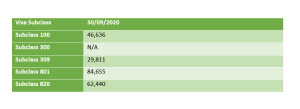Partner Visa Statistics
Partner visas are divided into five different subclasses. The five subclasses are as follow:
Subclass 309 – Partner (Provisional) Visa
Subclass 100 – Partner (Migrant) Visa
Subclass 820 – Partner Visa (Temporary)
Subclass 801 – Partner Visa (Permanent)
Subclass 300 – Prospective Marriage Visa
Subclass 309 and 100 are for overseas applicants whilst subclass 801 and 100 are for onshore applicants. As the name suggests, partner visa allows de facto partner or spouse of an Australian Citizen, Australian permanent resident, or eligible New Zealand citizen to migrate to Australia. The visa holders can live, work and study in Australia. Subclass 309 visa allows the applicant to travel to Australia to marry his/her partner. Recently, the government released some statistics on partner visas.
Grants, Refusals and Withdrawals
The data provided by the government outlines the number of visa approvals, refusals, and withdrawals during the 2020 program year. Based on the numbers, the Department is prioritising onshore applications as opposed to offshore applications. Comparing the number of visa grants, throughout July till September, the number of grants for onshore partner visas are more than offshore partner visas. This is due to the outbreak of COVID-19, which caused border closures and travel restrictions. Visa refusals have decreased compared to the same period last year. However, this may be due to the lower number of cases being processed. The number of withdrawals remains relatively similar each month.
Visa Grants
| Visa Subclass | 31/07/2020 | 31/08/2020 | 31/09/2020 |
| Subclass 100 (offshore) | 1,494 | 1,176 | 1,771 |
| Subclass 300 (offshore) | <5 | 7 | 13 |
| Subclass 309 (offshore- Prospective Marriage visa) | 573 | 558 | 983 |
| Subclass 801 (onshore) | 2,742 | 4,565 | 3,869 |
| Subclass 820 (onshore) | 2,177 | 1,643 | 1,883 |
Partner visa processing times
The global processing time for partner visa has increased due to COVID-19. Whilst the Department has been processing and finalising visa applications during COVID-19, the unavailability of some services are adding to the delay of the visa processing. For example, the disrupted accessibility to panel doctors has impacted applicants’ ability to complete the health checks and meet the visa requirements. The inability to satisfy these requirements has contributed to the delay. Comparing data from the same period last year, it is evident that there are significant delays in processing first stage partner visa (i.e. Subclass 309, 820 and 300). At a glance, the second stage of partner visa application processing has decreased; however, the number of cases on hand in July and August 2019 was higher than July and August 2020.
First stage partner visa processing times (SC820)
| July 2019 | July 2020 |
| 75% – 18 Months | 75% – 19 Months |
| 90% – 26 Months | 90% – 25 Months |
| August 2019 | August 2020 |
| 75% – 18 Months | 75% – 22 Months |
| 90% – 26 Months | 90% – 27 Months |
Second stage partner visa processing times (SC801)
| July 2019 | July 2020 |
| 75% – 19 Months | 75% – 18 Months |
| 90% – 26 Months | 90% – 25 Months |
| August 2019 | August 2020 |
| 75% – 17 Months | 75% – 15 Months |
| 90% – 24 Months | 90% – 23 Months |
Budget Announcement and Partner visas
The government announced in the budget that new changes will be introduced for partner visas. These include:
- Mandatory character checks on sponsor
- English language requirement will be put in place for the visa applicants and sponsors.
It is expected that the additional requirements that the government are putting in place would contribute to further delay and costs for the visa applicants. This is because the applicant and sponsor will have to complete additional requirements before the visa is granted. Take the mandatory character checks; for example; it will take extra time for the Department to vet the sponsor and approved the sponsor before the applicant can proceed with the visa application. However, these changes are unlikely to come into effect until mid-next year.
These are the budget announcements; however, as they are not yet legislated, there are still many speculations. We will publish more details as soon as we received more information from the government.









New 4-Tier Invitation System for 189 Visa
Australian Immi App for Biometrics
Remote Work and Travel Now Clearer for 491, 494 and 489 Regional Visa Holders
New 186 TRT Rule Adversely Impacts Medical Practitioners’ PR Pathway
Tasmania – Health and Allied Health Occupations List (TSE Pathway)